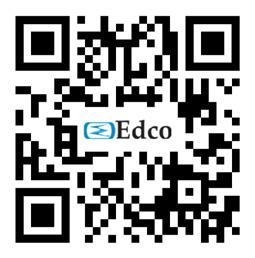
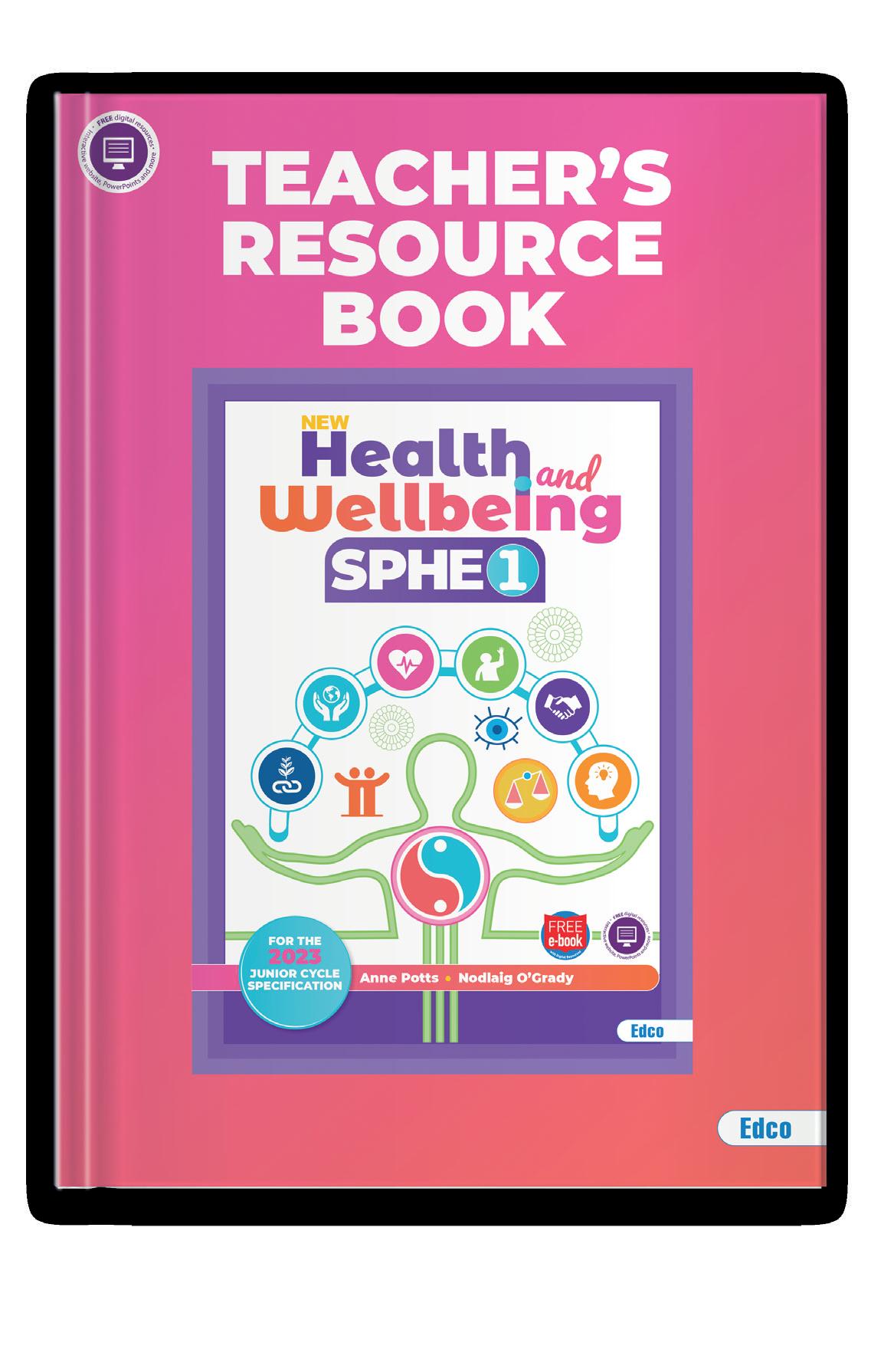

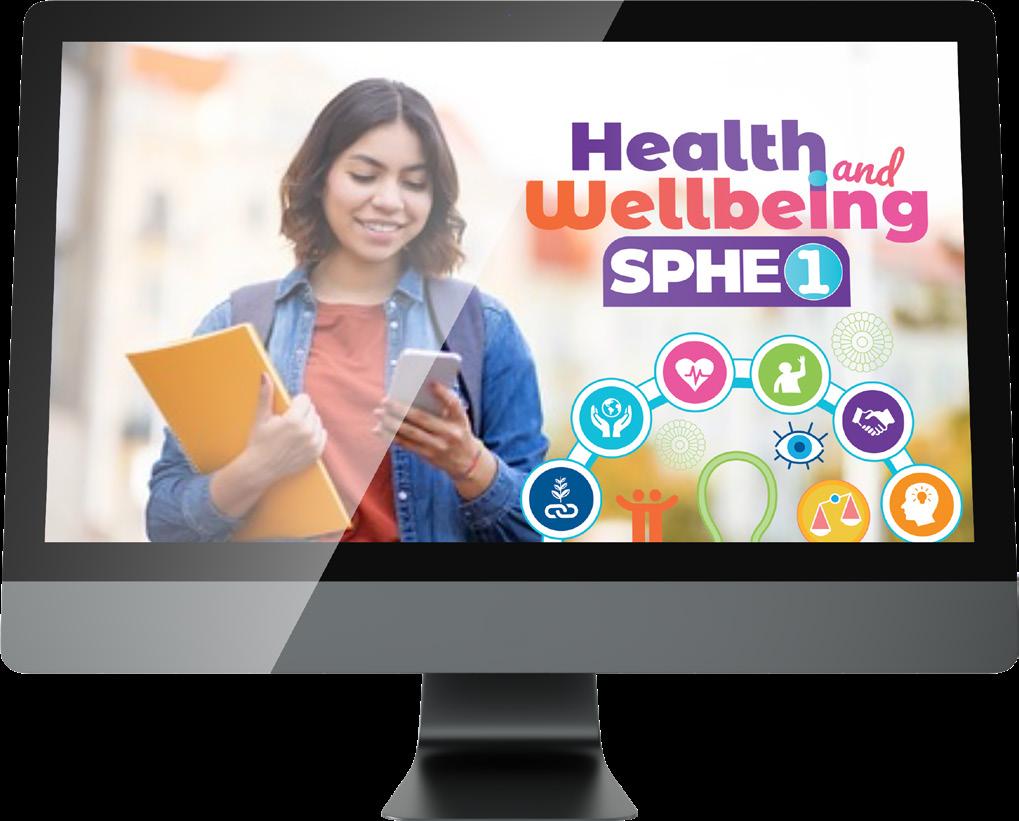
The Educational Company of Ireland Please contact your Local Edco Representative to book a presentation and request a sample copy, Ph: 01-4500611, Email: info@edco.ie, Website: www.edcopublications.ie FREE digitalresources . • . • V i d e os , Power P o ints and m o r e FREEdigita l resources NEW NEW NEW NEW
1
Anne Potts • Nodlaig O’Grady

NEW Health and Wellbeing: SPHE 1 has been written for the 2023 Junior Cycle SPHE Course specification. It covers the four strands and learning outcomes of the SPHE element of Wellbeing



The complete Package for Edco Health and Wellbeing: SPHE 1 contains:


Student Textbook
Teacher’s Resource Book
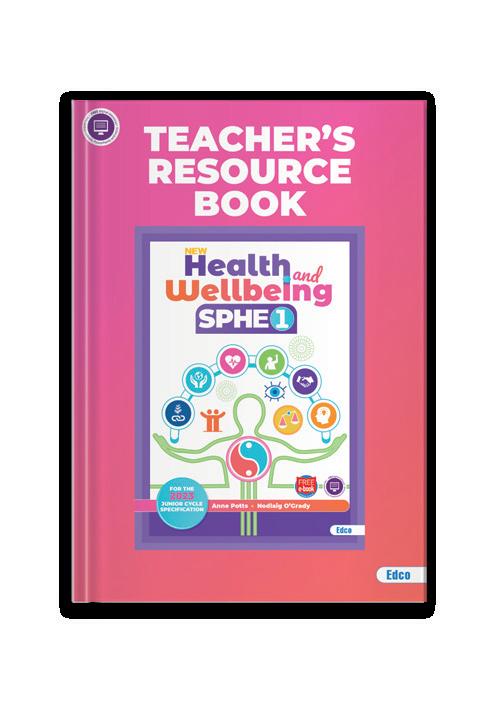


Free Digital Resources

STUDENT TEXTBOOK
Easy-to-read, bright and attractive design, with full-colour illustrations and engaging photos

Uses easily understandable and age-appropriate language










Each strand addresses each of the Eight Key Skills of the Junior Cycle
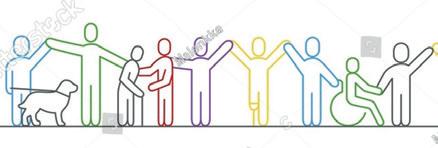

Includes new and updated, age-appropriate units on diversity, emotional health, advertising and young people, RSE, mindfulness, stress management and relaxation techniques

Comprehensively addresses all areas of SPHE as a core element of 2023 Junior Cycle Wellbeing programme

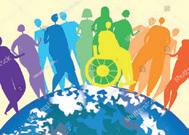
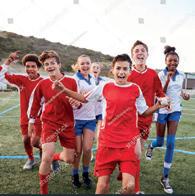
Not a ‘one size fits all’ lesson-based textbook –this publication allows class groups the flexibility to progress through each unit at their own pace
Includes a wide range of activities and assessment techniques which acknowledge the different learning styles and varying needs of students
Learning Intentions given for each unit, with quizzes and activities to establish students’ level of knowledge


Physical health includes making sure you exercise, eat a balanced diet, and get some rest and relaxation. Spiritual health refers to the things that give meaning and purpose to your life. It might be your beliefs and values, your religion, prayer, meditation, mindfulness or yoga. Social health involves spending time with your family and friends, joining club, having hobbies and doing fun activities like playing in a football team or being in a band. Emotional (mental) health includes recognising your feelings, managing stress, having fun and knowing when and where to ask for help. Physical health Spiritual health Social health Emotional (mental) health Leading a healthy and balanced lifestyle means that: • You get enough exercise, eat healthily and avoid getting involved in things that can damage your health, such as drugs. You can talk to others about your worries and problems and not bottle them up until they cause stress and anxiety. • You make time for meeting your friends, having fun and enjoying your hobbies, as well as building in time for schoolwork and chores. You make sure you get enough sleep, rest, relaxation and find other ways to recharge. Did you know ? If you lead a balanced life, you are more likely to be feel happier, healthier, less stressed and more fulfilled. 24 STRAND – Understanding Myself and Others www.edcosphe.ie r • FREE d gitalresources . • V d e os Power P oints and m o r e FREEdigita l resources
. V i d e os F
Activity 3 A C e d Diversity squares game below. Ask them to sign their name in that square. Each student can only sign one square. questions on the next page. different coloured eyes to you Can speak languagestwo Has a step-brother or sister Is allergic to something Was born in a country other than Ireland ALL DIFFERENT ALL EQUAL Has a larger family than you Has different religious beliefs to you Has never eaten bacon and cabbage Wears glasses Loves video games Is taller than you Dislikes sport Can perform a national dance Has a family member who is coeliac Has travelledEuropeoutside Is vegan Has a hidden talent Can’t sing Wears braces 68 STRAND 1 – Understanding Myself and Others Why is it important to have differences? Do you think it is difficult to be different in your school? Why is this? Diversity Diversity means differences. People may be different in many ways including race or ethnicity, age, disabilities, language, culture, appearance, religion, gender and sexuality. Key Word Definition This is an old Irish proverb that means we are all connected to each other and rely on each other. Ar scáth a chéile a mhaireann na daoine. We live in each other’s shadows. 69 UNIT 6 – All Different, All Equal Health check What does it mean to be healthy? 1. Think of as many words as you can that describe what being healthy means to you. Write them below. 2. Organise the words under the headings in the table below. Activity 4 Re p R ! A balanced and healthy life includes all four elements of health in it – physical, emotional, social and spiritual! REMEMBER PHYSICAL HEALTH EMOTIONAL/MENTAL HEALTH SOCIAL HEALTH SPIRITUAL HEALTH 25 UNIT 2 – Self-Management
Sexuality – What Does it Mean? You have already explored some of the ways in which you are changing physically, socially, psychologically and emotionally during adolescence. Sexual development is another natural part of growing up. During adolescence you will become more aware of your sexual identity and develop sexual feelings for other people. Sometimes, these feelings can be confusing and hard to understand. Understanding that they are a normal part of growing up will lay the foundations for healthy, safe decisions about sexual activity in adulthood. Coping with new feelings and learning about yourself can also be an exciting time. This unit helps you to: 1 Learn about aspects of human sexuality Become more aware of gender stereotyping in the world around us 3 Appreciate that sexual orientation and gender identity are part of what it means to be human 4 Explore ways of supporting someone who belongs to the LGBTQ+ community. Learning Intentions (Tick each topic off as you complete it.) Key Words Stereotypes Gender stereotyping Sexuality Sexual orientation LGBTQ+ Lesbian Gay Bisexual Transgender 154 RELATIONSHIPS AND SEXUALITY STRAND UNIT HUMAN SEXUALITY –SEXUAL ORIENTATION AND GENDER IDENTITY 2 3
NEW NEW
‘Reflections’ allow students to reflect on their learning and to keep a record of it, facilitating the completion of classroom-based assessments (CBAs)

Follows best practice in addressing the health and wellbeing needs of young people
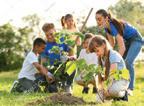
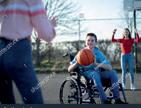



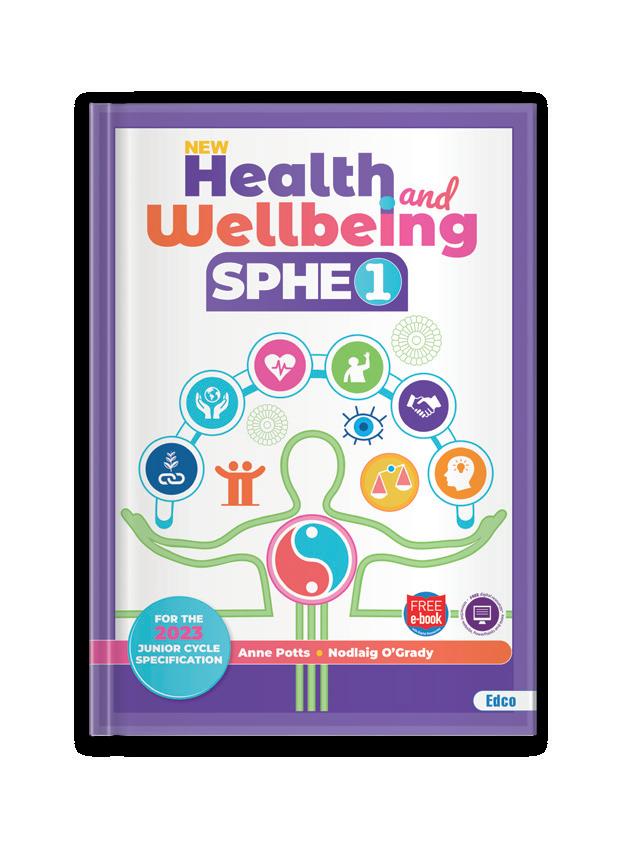
Cyberbullying covered in detail, with tips and suggestions for dealing with it
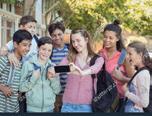


Key words are listed at the beginning of each unit and explained throughout the text
Wellbeing indicators are included for each activity


TEACHER’S RESOURCE BOOK

A Free Teacher’s Resource Book supporting this series provides:
Practical guidelines for implementing the new 2023 SPHE specification in a student-centred and empathetic way
An extensive section on teaching SPHE, including planning, assessment for learning, SPHE and interculturalism, SPHE policy, record-keeping and reporting to parents
Additional background information, as is necessary
A reference section, including website links for both students and teachers, thus enabling both to remain up to date on the full range of topics
Ways in which the activities may be adapted for varying classroom situations and a range of abilities including suggestions for differentiation and classroom management
Alternative methodologies suitable for mixed ability classes, pair and group work





Solutions to quizzes and crosswords

The Educational Company of Ireland r • FREE digitalresources . s , Power P oints and m o r e FREEdigita resources 1 and FREE digitalresou . nI
Bullying – how much do you know? We have all heard of bullying and you may think you know what it means. But how much do you really kno�� �o �nd out� your teacher �ill read aloud each of the statements below. Decide if you Agree, Disagree or are Unsure and tick the relevant box. Then, each person in the class holds up one of the �ra�c �i�ht pa�es from the back of this book: Green for Agree. Red for Disagree and Orange for Unsure. Activity 1 d STATEMENTS AGREEDISAGREEUNSURE 1 Bullying is just a bit of fun. 2 There is no bullying in my school. 3 Bullying can be a one-off incident. 4 Some people take bullying too seriously. 5 Bullying is deliberately carried out to hurt someone. 6 There is more bullying amongst boys than girls. 7 Girls and boys use different ways to bully people. 8 Everyone is bullied sometimes. 9 If a person is bullied, they should tell someone. 10 Everyone has a responsibility to stop bullying. 11 know what to do in my school if am being bullied. 12 There are different types of bullying. 13 If am being bullied, will always know who is doing it. Now, answer the questions below. Your teacher will go through the correct answers later. 1. �hich statement did you ha�e the most di�culty in choosin� a response to� 2. Which statement surprised you the most? Powerpoint xxxxxxxxxxxxxxxxxxxxxxxxxxxxxx Lorem ipsum dolor amet, consectetur adipiscing elit, sed do eiusmod tempor incididunt labore et magna aliqua. Ut enim ad minim veniam, quis nostrud exercitation ullamco laboris nisi ut aliquip ex ea commodo consequat laboris ONLY RESOURCE ONLY other ICON ADDITIONAL EXAMPLE Lorem ipsum dolor sit amet, consectetur adipiscing sed do eiusmod tempor incididunt ut labore. Student website Compare and Contrast 202 STRAND 4 – Emotional Wellbeing Understanding and Recognising Bullying It is important that you feel safe and happy in school. Some thin�s can a�ect this feelin� of safety. Bullying is one example of this. 203 UNIT 2 – Anti-Bullying Examples of Bullying Physical: Fighting, hitting, spitting, pinching, poking, tripping, pushing. Cyberbullying: Using information technology, like mobiles, laptops or tablets, to post hurtful information about someone online or to send nasty emails, texts or messages on social media websites like Snapchat or Twitter, or to upload embarrassing or damaging photos of them. Intimidation: Making people feel frightened, scared or uncomfortable by using threatening gestures, aggressive body language, tone of voice, facial expressions or ganging up on them. Name-calling: Making hurtful, humiliating insults and comments about someone. Social bullying:Isolating, excluding, ignoring, spreading rumours, passing notes, whispering, rolling eyes, mimicking, smirking behind someone’s back Damaging property: Breaking, stealing or hiding someone else’s property or defacing it including their clothes, schoolbag, homework, pencil case, books, mobile phone or their lunch. Identity-based: Name calling or violence against people based on disability or additional needs, gender, ethnicity, religion, sex, weight or any other aspect of a person’s identity. These categories of bullying are sometimes organised under four main types: physical, verbal, social and digital bullying. Sources of advertising In the list below tick the box for each type of advertising you are familiar with. In the blank spaces add others that you know about. Newspapers Magazines Billboards Bus shelters Television Radio Shopping bags Buses/Trains Logos on clothes Banners at sports events Sponsorship of games Cinema Others Video YouTube Product placement Instagram TicTok Twitter Email Google search Spotify Music videos Influencers Podcasts In-Game ads Others ?Advertisers target children because they are easier to get hooked on a product. Advertisers target children by using cartoon characters to promote their product which will make the child want the product. Advertisers also target children by having famous sports stars or actors to promote their products Did you know Young people are known to skip traditional TV ads. Advertisers know this so to they have come up with cleverer ways to market their products to young people. One of these marketing tools is product placement. Product placement is used in movies, TV shows, music videos and video games. It is a sneaky type of advertising because it incorporates the product into the script so the audience is not really aware that they are being manipulated. But of course they are! They unconsciously link the product with the glamour, excitement or image of the person or situation they are watching. In reality, an advertiser has paid large amounts of money for their product to be shown this way. Activity 10 Aw 134 STRAND 2 – Making Healthy Choices Some well-known movies are full of product placement. For example, Jurassic World placements include brands like Starbucks, Coco-Cola, Apple, Converse and Nike. Some products are shown up to 15 times. The James Bond movies are another example of product placement to glamorise alcohol and expensive cars. Do your own research and videos or video games. Managing advertising Think about the following questions carefully before you answer them. Activity 11 s b What skills or knowledge would help young people to manage the amount of advertising that they are bombarded with? 2 Where could you get these skills and information? One example of how I fell for an advertisement is Something I learned about advertising that I did not already know is Reflection 135 UNIT 2 – Unhealthy Products What is Health? In this unit we are going to look at what ‘being healthy’ means. To have good health doesn’t only mean that you are not ill. It also means that you are in a state of wellbeing (or being well) and feel good about yourself. This unit helps you to: Be aware of the importance of personal hygiene Understand what makes up a healthy diet 3 Know how to read and compare food labels 4 Appreciate the value of physical activity 5 Learn why sleep is important 6 Evaluate how your diet, physical activity, sleep/rest and hygiene can all contribute to your self-confidence, self-esteem and wellbeing Learning Intentions (Tickeachtopicoffas youcompleteit.) 82 HEALTHY CHOICES MAKING 2 STRAND UNIT BEING HEALTHY 1 Key Words Health – physical, social, mental Physical activity Vegetarian Vegan Carbohydrates Proteins Vitamins Minerals Fats Food Pyramid Eatwell guide Overall Health �et�s loo� at the di�erent types of health that the �H� tells us make up your total health: Physical health Physical health (or physical wellbeing) means having the energy and physical ability to get up every day and do what you need to do, like going to school. It also means getting enough sleep, eating well, feeling fi and being active. Ask yourself: Do get enough rest? Do eat the right �inds of foods� �o � feel well� �m � fit� Mental health Mental health includes how much you enjoy life and how good you are at coping with all the things that happen to you. Everyone has disappointments and things that don’t work out for them in their lives. Good mental health means you have the ability to cope with life’s ups and downs and any stress in your life. Another word for being able to do this is being resilient. Social health Social health is about how you get on with other people. Not everyone will be your friend, but you should be able to communicate, get along with people and be part of a community. Having good social health means you can make and keep friends, and those friends should make you feel good about yourself. Healthy relationships are based on respect, mutual trust and equality. ? Research by the National Institute of Ageing has linked social isolation and loneliness to higher risks for a number of physical and mental conditions such as high blood pressure, heart disease, obesity, a weakened immune system, anxiety, depression, confusion and memory problems, Alzheimer’s disease, and even death. Did you know Personal hygiene Personal hygiene means keeping your body clean. Good personal hygiene is important to your overall health. It reduces the spread of illness and infection. It can also increase your self-confidence and help you to make friends.’. • Physical health Mental health • Social health 83 UNIT – Being Healthy
Digital Resources
Teachers can access the Health and Wellbeing: SPHE 1 interactive e-book at www.edcolearning.ie, as well as a bank of free digital resources, including:

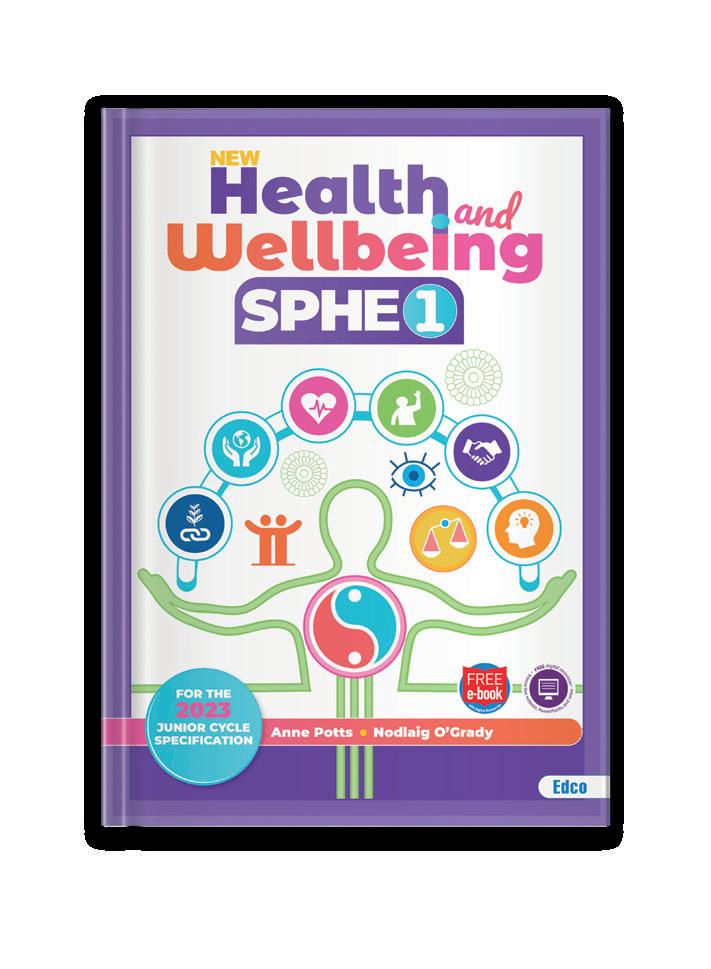


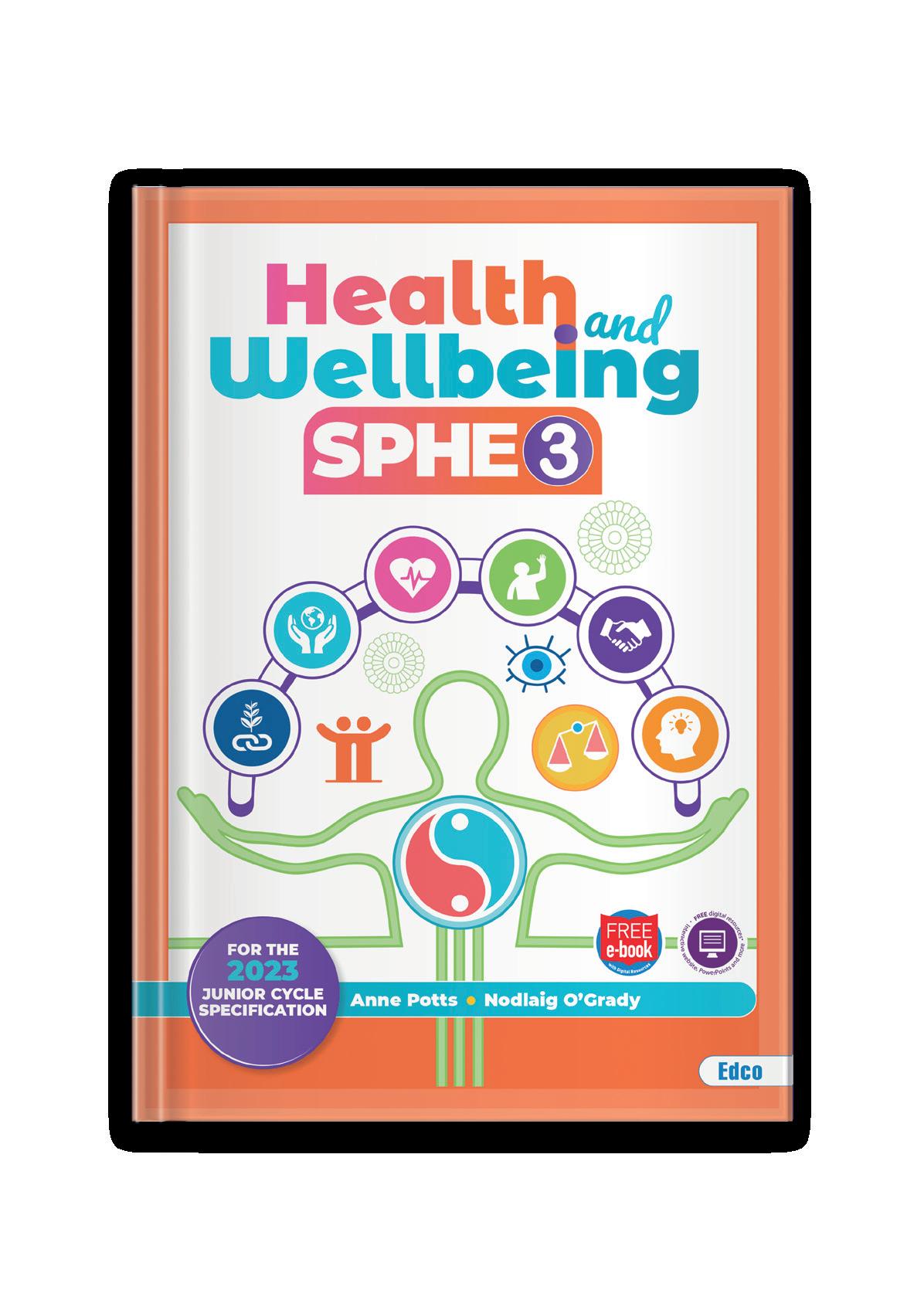
› A series of PowerPoints covering a range of key topics, including mental and physical wellbeing, substance use and relationships

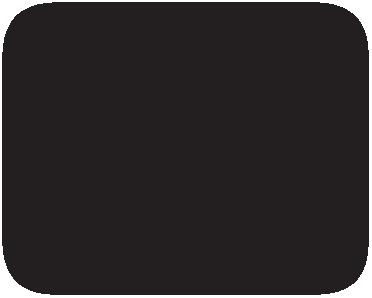
› Lively, scenario-based animations and informational videos for students to discuss in the classroom
› Interactive quizzes to consolidate learning
› Worksheets to accompany the animations and videos
› A comprehensive list of weblinks for each unit
Please
AVAILABLE SPRING 2024
contact your Local Edco Representative to book a presentation and request a sample copy, Ph: 01-4500611, Email: info@edco.ie, Website: www.edcopublications.ie The Educational Company of Ireland
NEW NEW























































